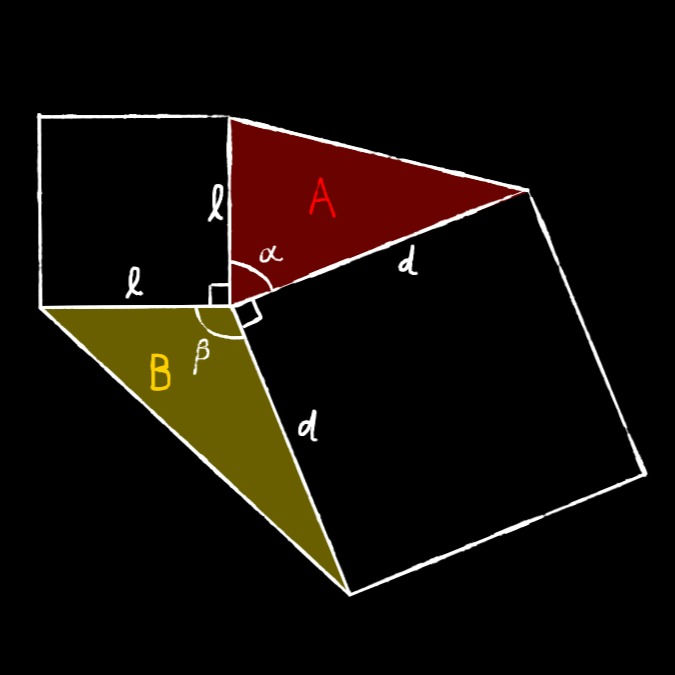Tower of Hanoi : Part 2 of 3
- XR - XharpRazor Axtra

- Feb 18, 2022
- 2 min read
Now since we know the background of the puzzle let's start proving the formula.
2 vital keys
Let's start with what we definitely know:
To solve an n-disk puzzle
step 1: use multiple steps to move n-1 disks from RodA to RodB
step 2: move the largest disk from RodA to RodC
step 3: use multiple steps to move n-1 disk from RodB to RodC
let's say the number of steps required to solve an n-disk Hanoi puzzle is T{n}, then we definitely know that
T{n} = T{n-1} + 1 + T{n-1} = 2T{n-1} + 1
/*
in this case, we use "{}" to state the subscript
total steps = step1(move n-1 disks) + step2(move the largest disk) + step3(move the n-1 disks again)
*/another thing that we definitely know that is
T{0} = 0
// you will need 0 steps to finish a 0-disk Hanoi puzzlethe Proof :
The main idea is to keep expanding T{n} until we reach the term T{0}. so here we go~
T{n}
= 2 T{n-1} +1
= 2 (2 T{n-2} +1)+1
= 2 (2 (2 T{n-3} +1)+1)+1
= 2 (2 (2 (2 T{n-4} +1)+1)+1)+1
.
.
.
= 2(2(2(2 ... 2(2(2(2T{n-n=0}+1 )+1 )+1 )+1 ...+1 )+1 )+1 )+1
= 2(2(2(2 ... 2(2(2(2T{n-n=0}+2^0)+2^0)+2^0)+2^0...+2^0)+2^0)+2^0)+2^0
= 2(2(2(2 ... 2(2(2(2^1 T{0} +2^0)+2^0)+2^0)+2^0...+2^0)+2^0)+2^0)+2^0
= 2(2(2(2 ... 2(2( 2^2 T{0} +2^1 +2^0)+2^0)+2^0...+2^0)+2^0)+2^0)+2^0
= 2(2(2(2 ... 2( 2^3 T{0} +2^2 +2^1 +2^0)+2^0...+2^0)+2^0)+2^0)+2^0
= 2(2(2(2 ... 2^4 T{0} +2^3 +2^2 +2^1 +2^0...+2^0)+2^0)+2^0)+2^0
.
.
.
= 2^n T{0} + 2^(n-1) + 2^(n-2) + 2^(n-3) + ... + 2^2 + 2^1 + 2^0since we know that T{0} = 0
what we have to deal with is the "2^(n-1) + 2^(n-2) + 2^(n-3) + ... + 4 + 2 + 1" part
first, we need to come up with a proof that we can "collapse" this string:
∀ x∈ℤ
2^x + 2^x
= 2^x(1 + 1)
= (2^x)(2)
= 2^(x+1)with this we can try to focus on that string, say that string is S, so we would have
S = 2^(n-1) + 2^(n-2) + 2^(n-3) + ... + 2^2 + 2^1 + 2^0
S + 2^0 = 2^(n-1) + 2^(n-2) + 2^(n-3) + ... + 2^2 + 2^1 + 2^0 + 2^0
= 2^(n-1) + 2^(n-2) + 2^(n-3) + ... + 2^2 + 2^1 + 2^1
= 2^(n-1) + 2^(n-2) + 2^(n-3) + ... + 2^2 + 2^2
= 2^(n-1) + 2^(n-2) + 2^(n-3) + ... + 2^3
.
.
.
S + 2^0 = 2^n
S = 2^n - 1 so if we plug this thing back in where we left off, we would have
T{n} = 2^n T{0} + 2^(n-1) + 2^(n-2) + 2^(n-3) + ... + 2^2 + 2^1 + 2^0
= 2^0 (0) + S
= 0 + 2^n - 1and so finally we have proved that the least number of required steps to solve an n-disks Tower of Hanoi puzzle is :
T{n} = 2^n - 1, ∀ x∈ℤ, x≥0
more stuff for Part 3











These posts are inspired by one of the math assignments I have from my Professor,
https://www.sdstate.edu/directory/ross-abraham
which is to solve a Hanoi puzzle of 6-disks under 6 mins with the least steps.
here's a link to a website where you can give it a try~
https://www.mathplayground.com/logic_tower_of_hanoi.html